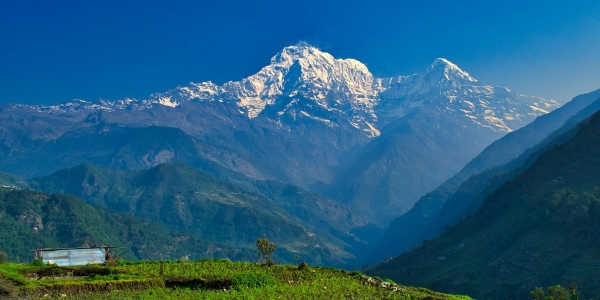Nepal is a trekker’s paradise, offering some of the most stunning landscapes and challenging trails in the world. From the towering peaks of the Himalayas to the lush valley and cultural richness, Nepal provides an unforgettable trekking experience. To ensure you have a successful trip, it’s important to know what to except in terms of food, accommodation and weather.
Food in Nepal's Trekking Areas
Nepalese cuisine in trekking areas is both diverse and hearty, designed to fuel trekkers for long days on the trail.
Staple Foods
Dal Bhat:
The quintessential Nepali meal, consisting of lentil soup (dal) served with rice (bhat) and accompanied by vegetable curries, pickles, and sometimes meat. It's nutritious and provides a balanced mix of proteins and carbohydrates.

Momos:
Steamed or fried dumplings filled with vegetables or meat. They are a popular snack and meal option among trekkers.

Thukpa:
A warm, hearty noodle soup of Tibetan origin, perfect for colder trekking days. It usually contains vegetables, meat, and a flavorful broth.

Tibetan Bread:
A type of fried bread that is often eaten for breakfast with honey or jam. It's filling and provides a good start to the day.
Yak Cheese:
Made from yak milk, this cheese is rich and nutritious. It's often found in higher-altitude regions where yaks are common.
Local Delicacies
Sherpa Stew:
A thick, hearty stew made with vegetables, meat, and noodles. It's a favorite among trekkers in the Everest region.
Tsampa:
Roasted barley flour mixed with tea or water, a traditional Tibetan staple that provides a quick and easy source of energy.
Tips for Eating in Trekking Areas
- Stick to Vegetarian Food: Due to the lack of refrigeration in many trekking areas, vegetarian food is often safer and fresher.
- Drink Boiled or Treated Water: Avoid drinking untreated water to prevent waterborne illnesses. Most teahouses offer boiled water, and it's wise to carry water purification tablets or a filter.
- Try Local Foods: Embrace the local cuisine for a more immersive experience and to support local businesses.
- Hotels and Accommodation in Nepal's Trekking Areas
- Accommodation in Nepal's trekking regions ranges from basic teahouses to more comfortable lodges.
Types of Accommodation
Teahouses:
- The most common type of accommodation on popular trekking routes like the Everest Base Camp and Annapurna Circuit. They offer basic rooms, usually with shared bathrooms. Meals are served in a communal dining area.
- Amenities: Basic beds, blankets, shared toilets, sometimes hot showers (for an extra fee).
Lodges:
- Slightly more upscale than teahouses, lodges provide better facilities and more comfort. Found in more developed trekking areas.
- Amenities: Private rooms, en-suite bathrooms, better dining options, Wi-Fi (in some places).
Guesthouses:
- Typically found in larger towns and cities at the beginning or end of trekking routes.
- Amenities: Private rooms, private or shared bathrooms, restaurant services, Wi-Fi.
Popular Trekking Areas and Accommodation
Everest Region (Khumbu):
- Namche Bazaar: A bustling hub with a range of accommodations from basic teahouses to luxury lodges.
- Lukla: The starting point of the Everest trek with many teahouses catering to trekkers.
Annapurna Region:
- Pokhara: The gateway to the Annapurna region with a wide variety of hotels, guesthouses, and lodges.
- Ghorepani: A popular stop on the Annapurna Circuit with numerous teahouses.
Langtang Region:
- Syabrubesi: The starting point for treks in the Langtang Valley with basic to mid-range accommodation options.
- Kyanjin Gompa: Higher up in the Langtang Valley, offering basic teahouses with incredible views.
Tips for Accommodation
- Book in Advance: During peak trekking seasons (spring and autumn), teahouses and lodges can fill up quickly.
- Carry a Sleeping Bag: While most teahouses provide blankets, a good-quality sleeping bag ensures warmth and comfort.
- Check Amenities: Not all teahouses offer hot showers or Wi-Fi. Confirm available amenities if they are important to you.
Weather in Nepal's Trekking Areas
Understanding the weather patterns is crucial for planning a trek in Nepal.
Best Time to Trek
Spring (March to May):
- Weather: Mild and stable with blooming rhododendrons. Ideal for trekking with clear skies and moderate temperatures.
- Temperatures: Ranging from 10°C (50°F) at night to 20°C (68°F) during the day at lower altitudes. Higher altitudes can be colder.
Autumn (September to November):
- Weather: Clear skies and stable weather after the monsoon season. Perfect for trekking with excellent visibility.
- Temperatures: Similar to spring, with cooler nights. Daytime temperatures at lower altitudes range from 15°C (59°F) to 25°C (77°F).
- Weather Patterns
Winter (December to February):
- Weather: Cold with potential snowfall at higher altitudes. Fewer crowds but harsher conditions.
- Tips: Suitable for lower-altitude treks or well-prepared trekkers with proper gear.
Monsoon (June to August):
- Weather: Heavy rainfall, landslides, and leeches make trekking challenging. Trails are muddy and slippery.
- Tips: Treks in rain-shadow areas like Upper Mustang and Dolpo are more feasible.
Tips for Weather Preparation
- Layer Clothing: Temperatures can vary greatly. Wear layers to adjust to changing conditions.
- Rain Gear: Essential during the monsoon season and useful for sudden rain showers in other seasons.
- Sun Protection: High-altitude sun can be intense. Use sunscreen, sunglasses, and a hat.
- Check Weather Forecasts: Always stay updated on weather conditions before and during your trek.
Conclusion
Trekking in Nepal is a rewarding experience that combines stunning landscapes, rich culture, and physical challenge. Proper preparation for food, accommodation, and weather ensures a safe and enjoyable journey. Embrace the local culture, be mindful of environmental impacts, and immerse yourself in the natural beauty of Nepal's trekking regions. Happy trekking!







